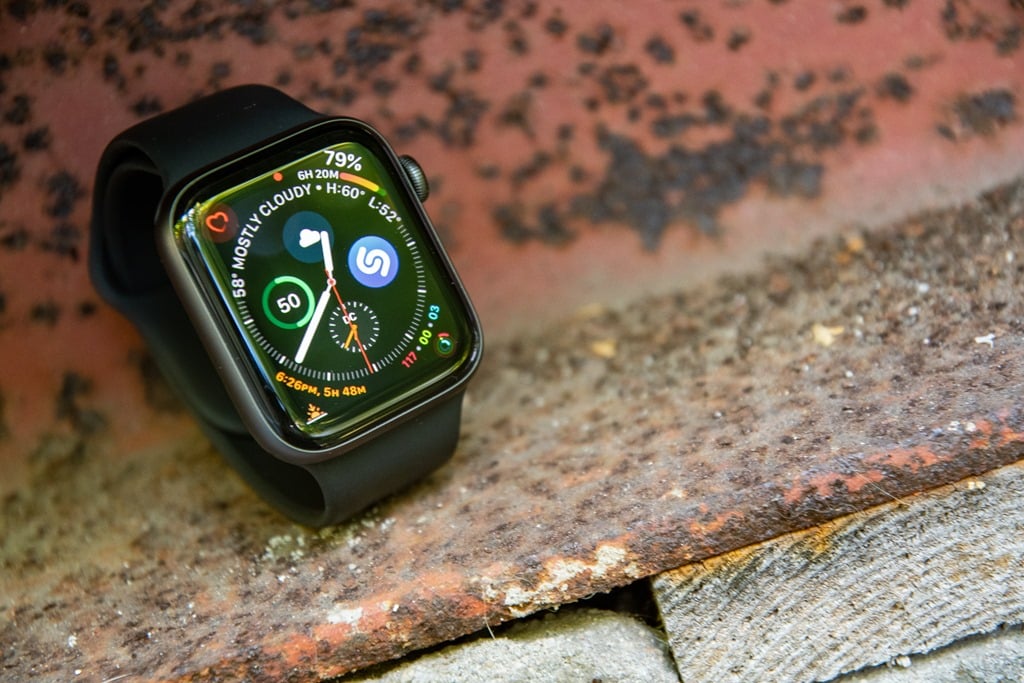
Apple Watch série 4: examen approfondi des sports et de la forme
Comme chaque heure d'automne, Apple a lancé la dernière génération d'Apple Watch – et cet automne n'a pas été différent. Parfois, ces modifications sont significatives d’une version à l’autre, et d’autres fois elles sont plus modérées.
Selon votre point de vue, cela pourrait relever de l'un ou l'autre camp. Du point de vue purement de la condition physique, l’extérieur et les caractéristiques de la 4ème génération ont été minimes. Au lieu de cela, les changements les plus importants sont apparus sous la forme d’une augmentation significative de l’affichage / de la taille de l’écran des deux modèles. Ainsi que la fonctionnalité ECG encore mise en œuvre que la société prévoit de publier plus tard cette année. Au-delà, la plupart des changements survenus au cours de l’année écoulée s’appliquent à WatchOS et s’appliquent à toutes les montres Apple.
Cependant, supposer qu’il n’ya pas eu de changement de condition physique sous-jacent serait la plus grande erreur que vous (ou toute entreprise de technologie sportive) pourrait commettre. L'aspect visuel différent du capteur de fréquence cardiaque optique situé en bas devrait indiquer que les choses ont changé. Et en fait, au cours des derniers mois, j’ai porté ce test là où l’Apple Watch avait devancé Garmin, Suunto et Polar en ce qui concerne la précision des mesures de la fréquence cardiaque, mais également du GPS. Pourtant, il ya aussi des moments qui vous font secouer la tête chez Apple.
Alors, est-ce la meilleure nouvelle montre de fitness sur le marché? Eh bien, c’est une question complexe qui dépend franchement de ce que vous attendez d’une montre de remise en forme. Il n'y a pas de réponse en noir et blanc. Au lieu de cela, je vais vous donner quelques milliers de mots et une centaine de photographies à mâcher.
Oh, et enfin, j'ai acheté cet appareil moi-même. En tant que tel, contrairement aux prêteurs de médias, je n’ai pas l’intention de le restituer par la suite et je l’ajouterai simplement à ma collection. Avec ça, on va cuisiner.
En fait, attends… une dernière chose. Comme le titre de ce post l'indique, il s'agit de sport et de fitness. C’est sur quoi je me concentre ici. Il existe de nombreuses autres revues qui testent des éléments tels que la connectivité LTE et les nuances d’Apple Music sur l’appareil. Au lieu de cela, je suis hyper concentré sur l'expérience de sport / fitness ici. Je l'ai? Bien.
Contenus
Déballage:
Je ne vais pas mentir – la Apple Watch Series 4 est sans conteste le plus beau vêtement de sport que j'ai jamais déballé.
Non, non, non… pas la montre elle-même: mais l'expérience réelle du déballage. Sérieusement, c’est incroyablement bien pensé.
À première vue, cela ressemble à une boîte de tous les deux ans:
Mais une fois que vous l'ouvrez, il se présente comme une fleur et montre des photos des différentes montres Apple. Assise au milieu se trouve la montre elle-même. Eh bien, une fois que vous retirez le couvercle de la poupée empilable russe intérieure:
Ensuite, vous trouverez la montre sur le côté dans un étui en tissu protecteur que vous n’utiliserez plus jamais. Mais je suppose que c’est la pensée qui compte ici:
Si vous retirez le papier à droite de celui-ci, vous trouverez le puck du chargeur et le cordon mural:
Mais ce que vous ne réalisez peut-être pas, c’est qu’il s’agit en réalité d’un niveau à relever. En dessous se trouve une boîte secondaire avec les bracelets de montre:
Cette boîte contient les bandes que vous avez sélectionnées dans le cadre de votre montre. Il s’agit en fait d’un élément de fabrication industrielle brillant, dans la mesure où cela signifie que vous pouvez conserver le même montage pour presque tout. Mais on peut plutôt échanger le composant de boîte sous-jacent en fonction de la demande.
Voici les sangles. Il y a à la fois une sangle moyenne / grande et une sangle plus petite dans chaque boîte.
Et voici toutes les pièces au total:
Le boîtier de la montre se trouve à l'intérieur de cette housse en tissu:
Et regardez de plus près la rondelle de chargement / l’adaptateur. C’est la même chose qu’avant:
Les bracelets glissent sur le côté de la montre, comme dans les années passées:
Comme vous pouvez le constater, ce type de déballage est sans égal dans l’espace. Nous avons vu de très près les montres Withings Activité d'il y a quelques années (qu'Apple imite ici), puis dans une moindre mesure les montres Garmin Chronos. Néanmoins, le fait que Apple accorde autant d’attention aux unités les moins chères est digne de mention.
Oh, et au cas où ce n’était pas évident, j’ai acheté la variante Apple Watch Series 4 la moins chère à 44mm. Edition non cellulaire, car la version cellulaire n’est pas disponible aux Pays-Bas.
Les bases:
À bien des égards, l’Apple Watch n’a pas beaucoup changé au fil des ans en ce qui concerne l’interface de base et la façon dont vous interagissez avec elle. L’appareil n’a toujours que deux boutons physiques: l’un oblong, puis l’autre en rotation (appelé couronne numérique). Vous pouvez appuyer sur les deux pour exécuter diverses fonctions et confirmations, mais vous pouvez également faire pivoter la couronne numérique. Elle est souvent utilisée pour faire défiler des listes d'options vers le haut ou vers le bas, ou pour effectuer un zoom avant ou arrière.
Bien qu'Apple ait un vaste magasin d'applications pour l'Apple Watch, il n'y a toujours pas de magasin pour les visages de montres pour l'Apple Watch, ni aucune méthode permettant aux développeurs externes de les personnaliser. Au lieu de cela, la société nous a donné un nouveau cadran de montre cette année, rempli d'informations. Comme le quinoa, vous l’aimerez ou le détesterez. Et dans ce cas, comme le quinoa, il a poussé sur moi. Quand je l’ai vu pour la première fois, j’ai considéré cela comme une abomination de l’après-Jobs Apple.
Mais avec le temps, j’en suis venu à apprécier les détails. Même si je n’ai absolument aucune utilisation possible pour 80% des informations à l’écran. Force UV? De qui plaisante-t-on – je vis aux Pays-Bas, il fait nuageux presque tous les jours.
Vous pouvez personnaliser ces morceaux de données, mais à la même place que les visages que vous avez sélectionnés.
Regardez les visages de côté, en ce qui concerne l'installation d'applications, cela se fera via votre appareil iOS. Remarque, j'ai bien dit appareil iOS. Les téléphones Android et les 7 autres utilisateurs de Windows Phone ne sont pas pris en charge. Contrairement au Wear OS d’Android, qui permet aux téléphones iOS d’être associés à leurs montres, Apple ne le voit pas de cette façon. C’est tout Apple tout le temps ici.
Dans tous les cas, les applications sont transférées de votre appareil iOS vers la Apple Watch via la section "Ma montre". Presque toutes les applications que vous avez ont une forme d’application compagnon Apple Watch. Même si cette application compagnon est la plupart du temps inutile. La raison en est que Apple fait pression sur les entreprises pour qu'elles développent des applications associées afin d’obtenir un classement plus élevé et un statut «présenté» dans Apple App Store. Cela a pour effet de créer de nombreuses applications de surveillance qui ne font rien d’autre que afficher des notifications à partir desdites applications.
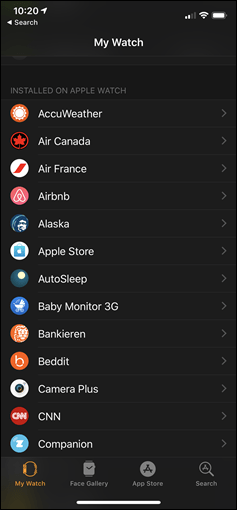
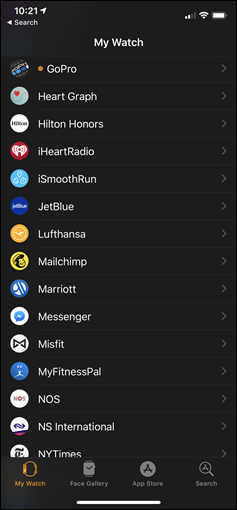
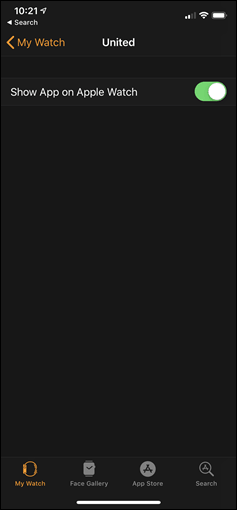
Vous pouvez activer ou désactiver des applications individuelles à votre guise à partir de l'application ci-dessus sur votre téléphone. De plus, vous pouvez utiliser cette même application iOS pour configurer les faces de la montre, ainsi que d'autres paramètres de la montre, tels que le mode de traitement des notifications.
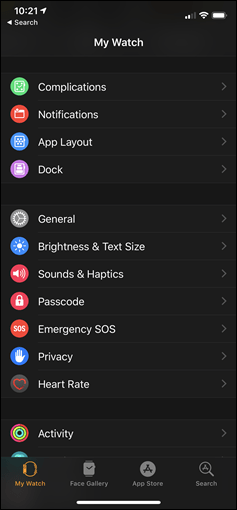
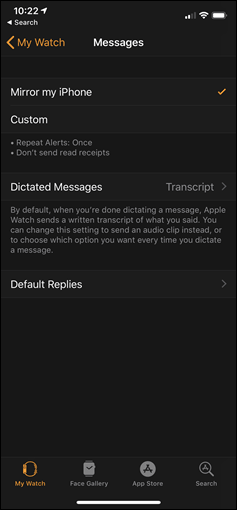
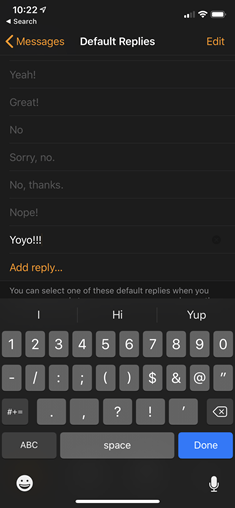
Et c’est vraiment en fouillant dans ces paramètres que vous commencez à voir les différences les plus significatives entre l’Apple Watch et la plupart des autres appareils portables de fitness. Par exemple, dans l’option messages, vous pouvez modifier et ajouter des messages personnalisés qui constituent des réponses instantanées. Ce n'est pas disponible sur iOS pour d'autres smartwatches.
Bien sûr, on ne peut blâmer que Garmin, Fitbit ou d’autres – c’est directement le résultat du jardin muré d’Apple. Voir que ces autres sociétés ont des réponses intelligentes pour certains de leurs nouveaux appareils sur les téléphones Android. Mais pas iOS. Apple bloque ce problème en utilisant les intégrations natives et n'autorise que leurs propres montres à exploiter / personnaliser cela.
Que vous utilisiez ou non cette fonctionnalité, c'est quelque chose qui distingue un peu Apple. C’est une partie de la plus grande attention portée à la nuance d’Apple avec l’Apple Watch que d’autres n’ont pas. Je parle souvent de notifications et de la manière dont elles sont conservées jusqu'à ce que vous tourniez votre poignet pour les afficher. Contrairement à la plupart des autres appareils portables, affichez-les au moment où ils arrivent – montrez vos sexts à vos collègues autour de la table de conférence. Ou, cela pourrait aussi être quelque chose de moins risqué, comme si quelqu'un vous donnait des accessoires pour une balade de 3 minutes sur Zwift.
C’est en partie la raison pour laquelle il ne fait aucun doute dans mon esprit que l’Apple Watch est la meilleure smartwatch complète. Je ne vois aucune autre montre qui se rapproche de ce niveau de nuance répété. Mais cela ne veut pas dire que c’est la meilleure montre de fitness.
Par exemple – il n’a toujours pas de suivi du sommeil – une caractéristique commune aux trackers d’activités de 50 $ autour du monde. Bien sûr, certaines applications tierces sur l'Apple Watch peuvent être exploitées, mais elles sont généralement un peu compliquées à utiliser.
En ce qui concerne le suivi des activités quotidiennes, l’appareil surveille les pas et la fréquence cardiaque, ainsi que votre temps de repos. Les escaliers ne sont pas considérés comme des anneaux, mais vous pouvez le voir dans le téléphone et regarder des applications d'activité. Vous pouvez configurer certaines options pour le suivi des activités dans l’application de configuration Watch, mais la plupart des suivis d’activité se font via l’application ‘Activity’ de votre téléphone (à gauche – appli de surveillance, application d’activité):
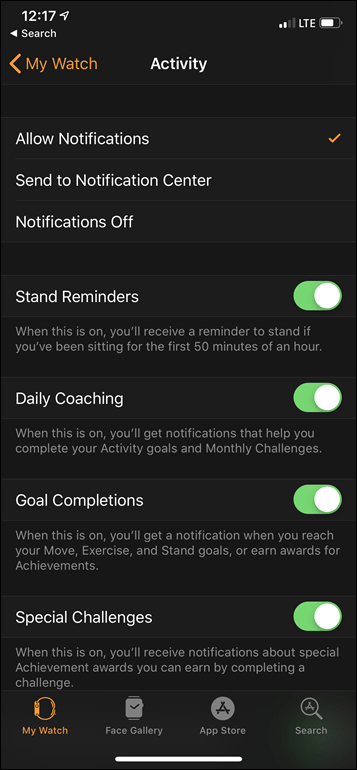
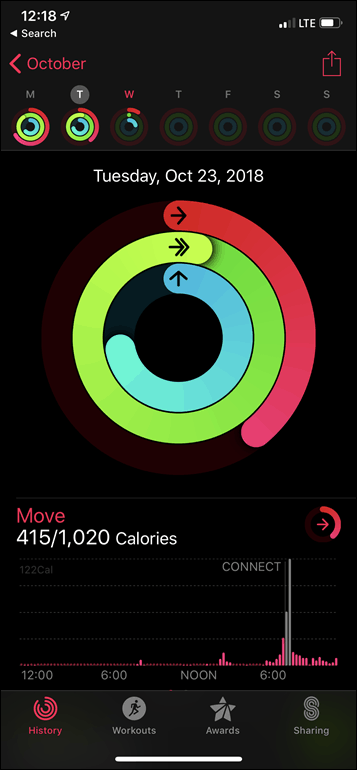
Tout cela reflète ce que vous voyez sur votre montre elle-même, à la fois dans la zone d'activité et sur la plupart des faces de la montre:
L’objectif ultime de votre Apple Watch est de «fermer» les anneaux. Chaque anneau représente un objectif quotidien différent à atteindre. Rose / Rouge pour l'objectif de déplacement, Vert pour l'objectif d'exercice et Bleu pour l'objectif permanent. Chaque objectif diffère, mais si vous complétez les trois objectifs, vous n'obtenez absolument rien.
La montre elle-même vous le rappellera à 10 minutes au plus tard (10h50) pour compléter votre objectif permanent, si vous ne l’avez pas encore fait:
Plus vous portez votre montre, plus vous accumulerez de succès. Ces réalisations apparaissent dans l'application "Activité" de votre téléphone et s'appliquent à toutes sortes d'objectifs aléatoires, tels que le multiplicateur de vos objectifs de déménagement ou autres:
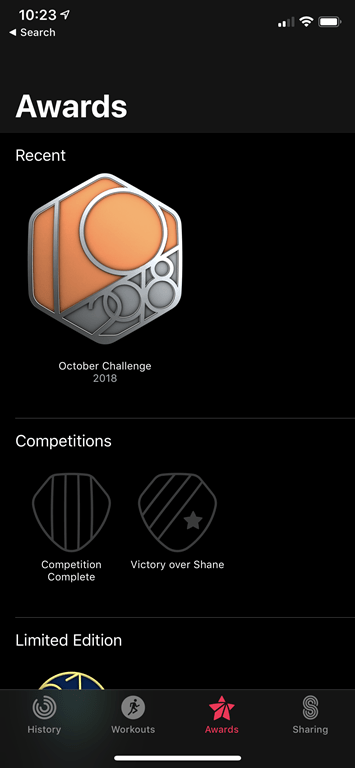
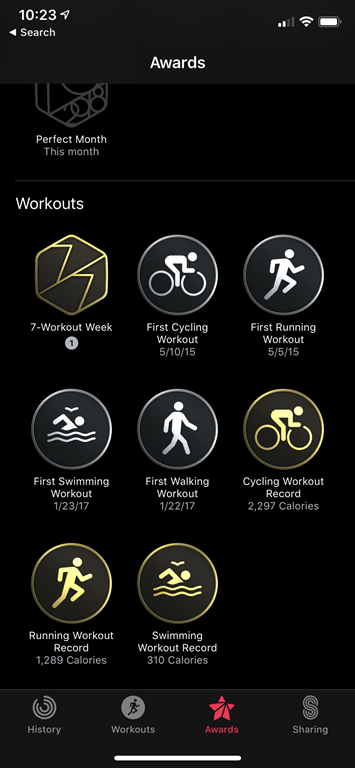
C’est également dans ce même domaine général que vous pouvez consulter votre historique des anneaux au fil du temps et explorer chaque jour:
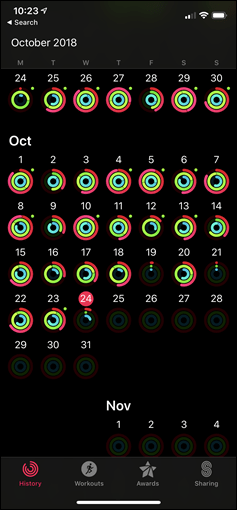
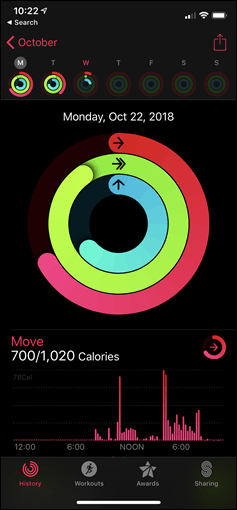
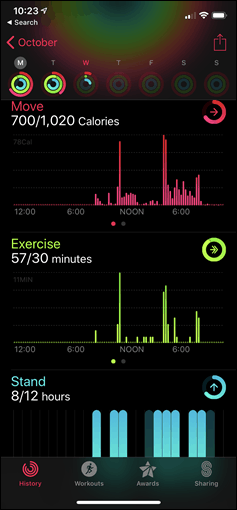
Et de plus, c’est là que vous pourrez concurrencer les autres. Sauf qu’ils ne l’appellent pas vraiment en compétition ici. Au lieu de cela, c’est juste du «partage». Vous pouvez donc inviter d'autres personnes et elles peuvent vous inviter. À partir de là, vous pouvez voir comment vous vous êtes comporté contre eux en termes d’anneaux d’activité ou même d’entraînements.
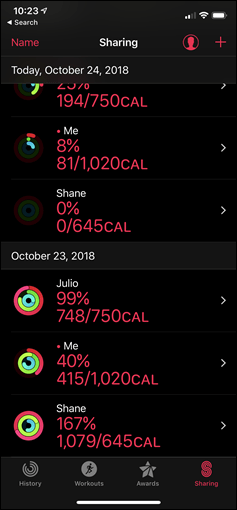
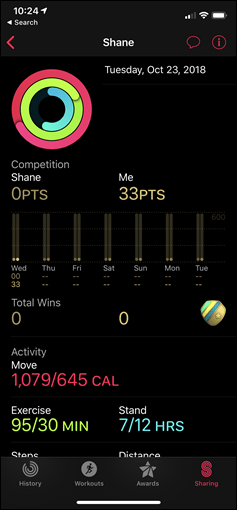
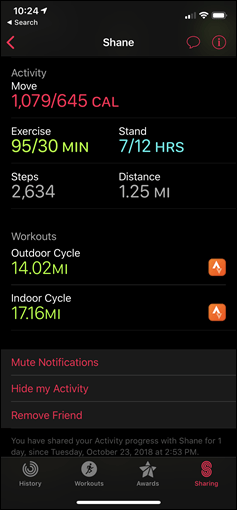
Si vous voulez vraiment faire concurrence à une personne, vous pouvez la défier de surveiller de façon excessive pendant sept jours Sex and the City. Ou juste 7 jours de fermeture du ring. Votre choix, cependant, l’Apple Watch ne suivra que l’un d’eux.
La plupart de ces avantages sont toutefois assez élémentaires par rapport aux offres de Fitbit. Tant au niveau des compétitions que des éléments sociaux généraux. Tout dans l’écosystème social d’Apple Watch est très sombre et impersonnel. Probablement parce que c’est exactement ce que l’application est. Alors qu'avec Fitbit, Garmin et d’autres, c’est une interaction très visuelle avec des photos de vos amis et de leurs exploits. En bas, Garmin à gauche et Fitbit à droite.
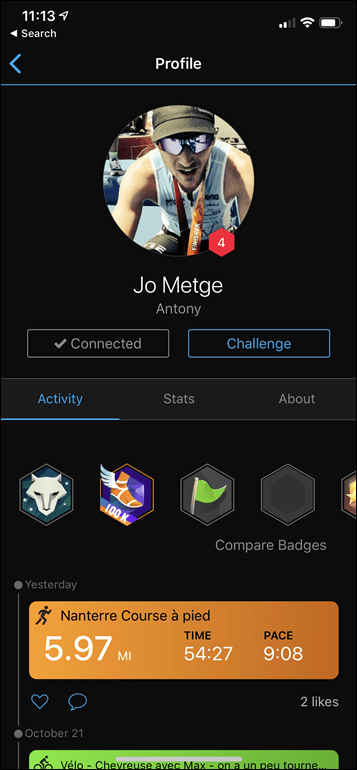
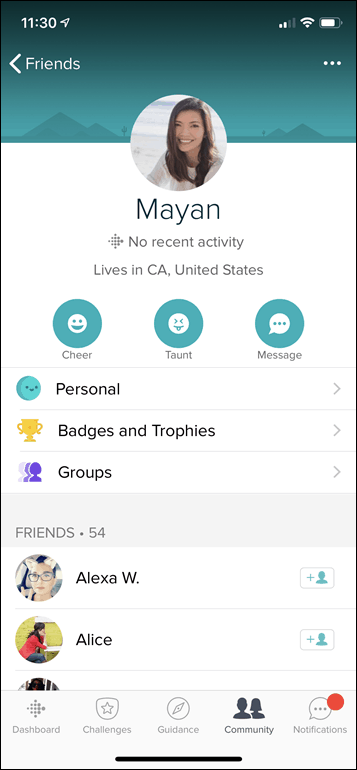
Avant de terminer, faute d’autre chose, Apple correspond à ce que la plupart des autres entreprises font au sujet des rappels occasionnels. Je veux dire, pas comme respirer pour rester en vie – mais respirer pour réduire le stress. Il vous permet de suivre une courte routine sur votre montre et vous rappelle de prendre l'habitude de le faire.
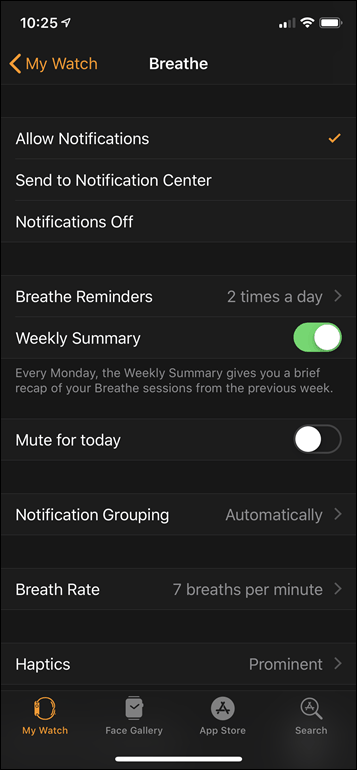
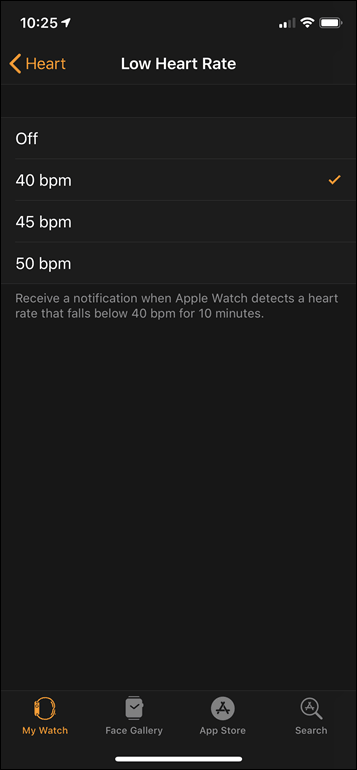
Enfin, bien qu’Apple n’ait pas encore mis en œuvre la fonctionnalité ECG, il a étendu les alertes de fréquence cardiaque au cours de l’année écoulée, passant d’une alerte de fréquence cardiaque élevée à une alerte de fréquence cardiaque minimale. L'année dernière, lorsque j'ai examiné l'Apple Watch Series 3, je recevais souvent des alertes faussement positives pour les ressources humaines élevées (alors que ce n'était pas le cas). Mais cette année, je n’ai pas encore reçu un seul faux positif.
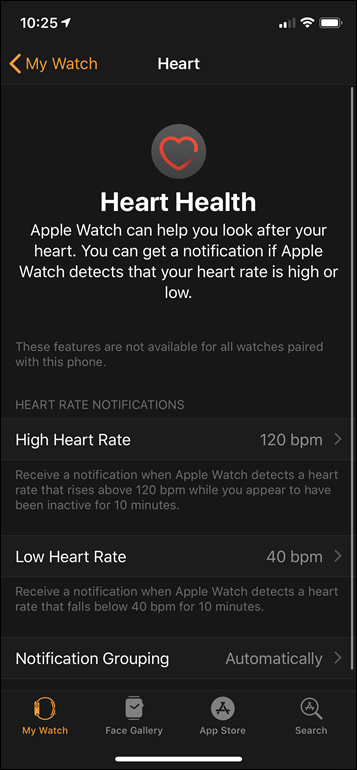
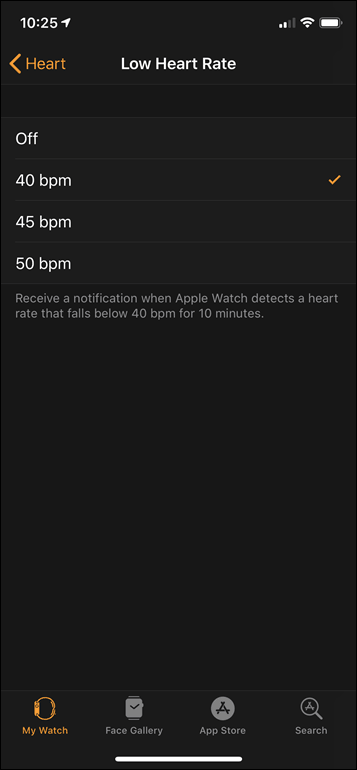
Bien sûr, ce que la plupart des gens attendent, c’est Apple qui publie la fonction ECG et la possibilité pour eux de détecter également certaines conditions, telles que le rythme irrégulier, et de vous présenter une notification. En outre, la société prévoit de faciliter l'utilisation de la fonction ECG par les personnes pour que les médecins transmettent les données au format PDF, et que la fonctionnalité ECG soit approuvée par la FDA (Food and Drug Administration aux États-Unis) en tant que dispositif médical. Ci-dessous, un extrait du discours d’Apple à ce sujet.
Cela fait partie du domaine des logiciels en tant que dispositifs médicaux, une question dont j’avais déjà parlé un peu dans le passé avec d’autres produits et de mon discours principal. Cependant, comme la fonctionnalité n’existe pas encore aujourd’hui, je ne peux pas la tester. Je vais donc garder ça pour une date ultérieure. Notez que je suggérerais aux gens de lire ce fil pour comprendre un peu derrière ce que fait Apple du point de vue d'un médecin. Je ne suis pas d’accord avec tout – mais je pense que c’est une bonne représentation globale de ce que la technologie est capable de faire.
Encore une fois, je vais aborder cette question plus en détail une fois que Apple aura publié cette fonctionnalité.
Utilisation sportive:
Contrairement aux années précédentes, Apple n’a annoncé aucune nouvelle fonctionnalité logicielle spécifique à l’entraînement dans la Apple Watch Series 4. Auparavant, les principaux événements de cette annonce étaient riches en points forts sportifs et en fitness. Cette année? Hausser les épaules.
Ce qui ne signifie pas que les choses n’ont pas changé. Parce que pendant cette même période, Apple a également abandonné Apple WatchOS 5, qui a mis à jour le logiciel de la montre Apple Watch dans toutes les variantes. Et même depuis l’année dernière, de nombreux changements mineurs ont été apportés à cette plateforme.
Néanmoins, commençons par les bases – et c’est l’application d’entraînement ouverte. Bien qu'il existe d'innombrables applications de sport / fitness tierces, je vais me concentrer pour le moment sur celles de base d'Apple (voir ma dernière section sur les applications tierces). L'application d'entraînement est celle ci-dessous, vert jaunâtre:
Après quoi, vous verrez une liste de sports que vous pouvez choisir. Si vous appuyez sur les trois points du cercle, vous pourrez personnaliser l’objectif de la séance d’entraînement. Par défaut, quand on dit «Open Goal», cela signifie que vous allez faire du sport aussi longtemps que vous le souhaitez, ou jusqu’à ce que vous vous effondriez (à quel moment, il vous demandera après un certain temps si vous voulez suspendre votre travail. séance d'entraînement – sans blague).
En outre, c’est ici que pour certains sports (comme la course à pied), vous pouvez définir une alerte de rythme (nouveauté dans Watch OS 5). Vous pouvez même l'appliquer au rythme de roulement ou moyen, ce qui est une belle touche.
Et pour certains sports – comme les séances d’entraînement HIIT, il vous avertira même que le type d’entraînement peut entraîner de mauvaises lectures optiques HR:
La liste complète des sports est la suivante: Marche en plein air, Course en plein air, Cycle en plein air, Marche en intérieur, Course en salle, Cycle en salle, Exerciseur elliptique, Rameur, Stepper escalier, Entraînement par intervalles à haute intensité, Randonnée, Yoga, Natation en piscine, Natation en eau libre et autre.
Vous pouvez personnaliser divers paramètres via l'application Watch sur votre téléphone. Celles-ci incluent Exécution d’une pause automatique, Mode économie d'énergie (désactive la fonction HR optique), Rappels de début / fin d’entraînement, ainsi que des listes de lecture d’entraînement. Personnellement, je quitte le mode d'économie d'énergie et je fais une pause, car je veux toutes les données!
De plus, si votre équipement de gym est compatible avec la fonctionnalité GymKit d’Apple, vous pouvez également l’utiliser. Malheureusement, aucun de ces gymnases auquel j'appartiens n'a cela.
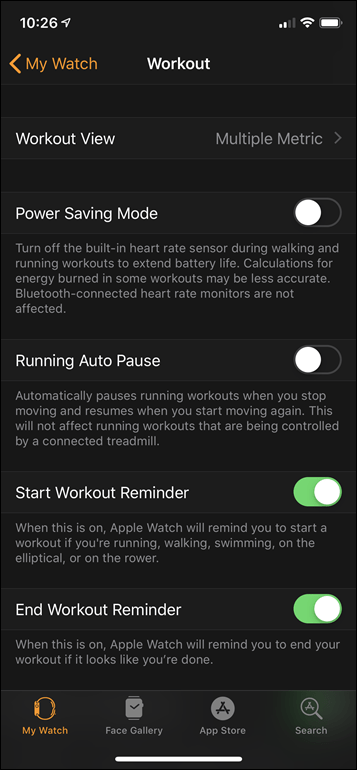
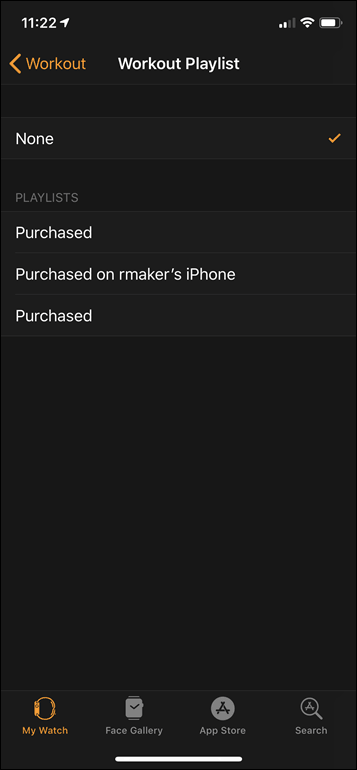
Pour chacun des types d'entraînement, vous pouvez sélectionner les champs de données que vous souhaitez afficher, ainsi que spécifier si vous souhaitez afficher plusieurs métriques sur un seul écran ou les afficher individuellement sur une seule page. Les deux sont dans l’option ‘Vue entraînement’. Vous pouvez sélectionner jusqu'à 5 mesures personnalisées à inclure:
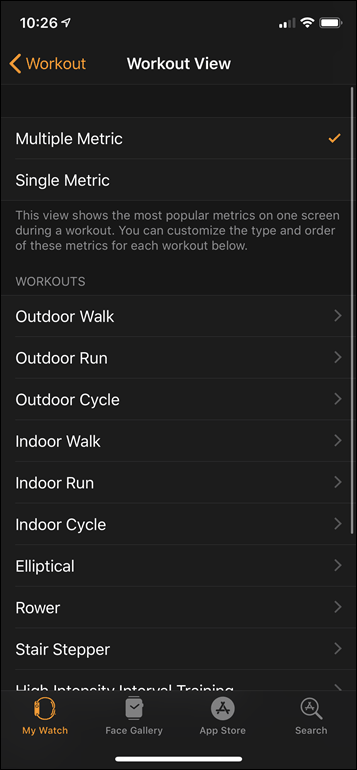
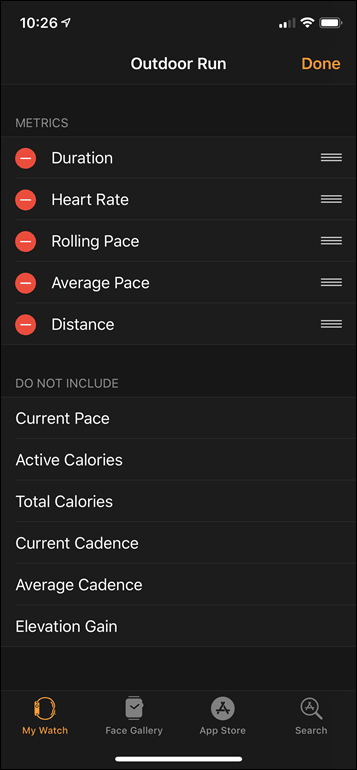
Au cours de la dernière année, dans Watch OS 5, ils ont ajouté l’option de cadence progressive, qui aide à stabiliser les légères fluctuations de la cadence GPS (ou de votre cadence) en vous donnant constamment la moyenne du dernier kilomètre. C’est quelque chose que nous avons constaté il ya de nombreuses années sur certaines anciennes montres GPS Timex, mais aucune entreprise traditionnelle n’a encore adopté (et c’est dommage, car c’est plutôt utile).
Avec tous ces éléments triés comme vous le souhaitez, de retour sur votre montre, vous sélectionnerez un sport / config, puis vous lancerez l’activité. Il vous donnera un compte à rebours de trois secondes.
Et c’est pendant ces trois secondes que l’élément le plus «controversé» de l’Apple Watch se dévoile. Et par «controversé», je veux dire que la plupart des critiques de technologies l’ignorent, mais c’est ce qui distingue fondamentalement l’Apple Watch de tous les autres dispositifs portables de fitness. Et malheureusement, pas dans le bon sens.
Vous voyez, normalement, lorsque vous avez une montre GPS de fitness et que vous passez en mode sport, deux choses distinctes se produisent:
1) L’acquisition GPS commence: Il sort et trouve des satellites. Dans la plupart des cas, cela ne prend que quelques secondes avec les nouvelles montres. Mais cela pourrait prendre plus de temps dans des endroits difficiles comme NYC. Si votre téléphone se trouve à proximité, Apple utilise le GPS du téléphone. Je le répète: la Apple Watch utilisera * toujours * le GPS de votre téléphone au lieu de son GPS, sauf si le téléphone n’est pas accessible.
2) L’acquisition optique de la fréquence cardiaque commence: Apple surveille en permanence votre FC en mode 24 × 7, mais utilise en fait un ensemble différent de capteurs de faible puissance pour économiser la durée de vie de la batterie. Lorsque vous passez en mode d’entraînement, il change la donne et a besoin de retrouver la fréquence cardiaque avec des capteurs et des algorithmes plus adaptés aux activités d’entraînement difficiles (c’est en fait normal pour de nombreux appareils portables).
Ces deux tâches prennent du temps. Mais Apple ne pense pas que le temps soit sexy, il compte donc jusqu'à trois comme un enfant en bas âge et espère que tout ira pour le mieux. Après quoi, vous allez penser que tout est prêt. Mais en réalité, ce n'est presque jamais le cas. Vous obtenez donc des lacunes dans les données. Vous remarquerez que votre fréquence cardiaque n’a pas été affichée au départ:
En fait, si vous consultez des graphiques pour connaître la fréquence cardiaque au cours des 90 premières secondes, celle-ci est souvent absente ou sera remplacée par une fausse valeur jusqu’à ce qu’ils obtiennent le verrouillage HR. Ici, il est comparé à une ceinture pectorale pendant les 90 premières secondes d’un entraînement:
Le GPS peut également être identique – il manque souvent le premier peu de votre entraînement jusqu'à la fin de son acquisition, en fonction du scénario. Note that distance isn’t usually significantly impacted for running, since it’ll use the accelerometer to estimate distance instead during that time period. For cycling though (without a phone on you), it’ll be incorrect.
What’s funny about this (and this was the same last year too) is that the act of ne pas attendre actually increases the inaccuracy. It makes it harder for heart rate to acquire, and harder for GPS to acquire. In reality, if Apple were to just show GPS/HR status icons like every other watch – then you might wait a few more seconds but your data would be present and accurate.
Still, that’s not sexy and polished like the Apple mantra. And you think this focus on sexiness ends here? Nope, Apple actually fictionally smooths your corners in GPS tracks to make them look sweeping and majestical. But only in their own app. Check out these side by side GPS tracks between the Apple Watch and a Garmin and Suunto watch. Note where I enter/exit the looped track, the Apple Watch makes sweeping curves (I didn’t run that way). The Garmin and Suunto watches correctly show the actual track.
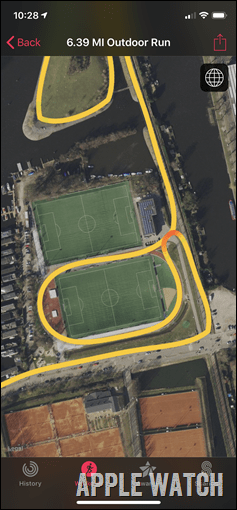
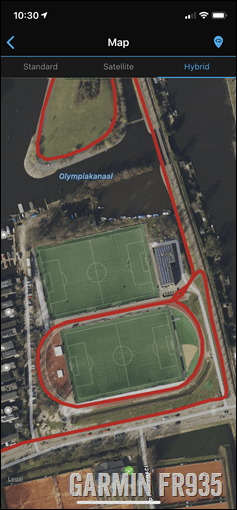
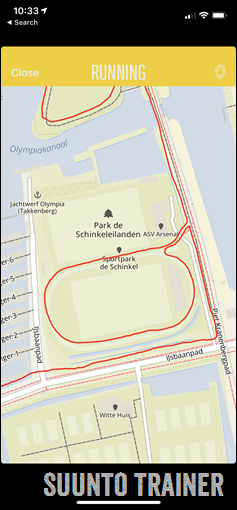
And again around these corners:
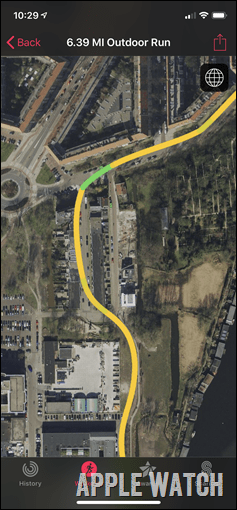
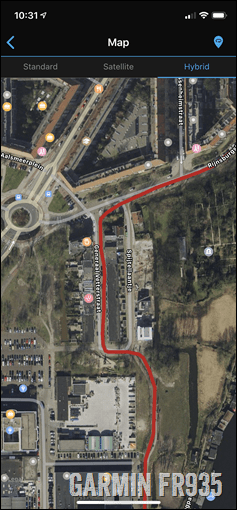
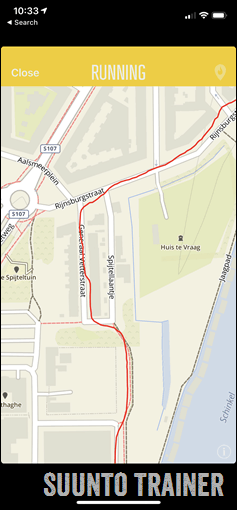
While certainly Apple has the Nike variant, it appears they’ve taken the co-branding a bit too far. The entire mantra of Apple’s GPS accuracy in their app appears to be ‘Just Swoosh it’ when it comes to corners.
In any case, we’ll talk more about accuracy in a moment (both heart rate and GPS). In the meantime, back to our run. As you remember we were just starting it before I got sidetracked. Once running (or riding or whatever) you’ll see your stats displayed.
With the default app you don’t really get a ton of stats. If you want more stats you’ll want to look at 3rd party apps like iSmoothRun for example.
Remember that the Apple Watch is *not* an always-on display. As such you won’t see the data until you raise your wrist. In general this isn’t an issue, as Apple’s wrist-raising detection algorithms are very good. But some people prefer the always-on aspect of other brands.
If you’ve enabled features like auto-lap, it’ll trigger notifications every kilometer or mile. Note that the Apple Watch can connect to 3rd party Bluetooth Smart heart rate straps, in the event you don’t trust the optical HR sensor. It cannot connect to ANT+ straps though. Of course, many straps these days are dual ANT+/Bluetooth Smart, like the Wahoo TICKR series or 4iiiii Viiiiva.
For sports like pool swimming, it’ll ask you to confirm the pool-size. Pool swimming won’t use GPS of course, but rather the accelerometer internally, so it needs to know the length of the pool to be able to determine the total distance. And interestingly, over the past year Apple has added the option to do non-standard pool sizes, such as the semi-common 33 and 1/3rd meter pool size that you’ll find in Europe in many places:
And for all swimming, including openwater swimming, it’ll let you know that the touchscreen will be locked until you rotate the digital crown.
This actually serves two purposes. One, it keeps the touchscreen from dorking with your swim. But also it uses the speaker when you unlock it to eject out the water from the microphone hole. Apple had a little illustration in their keynote a few years ago showing it. It’s kinda brilliant:
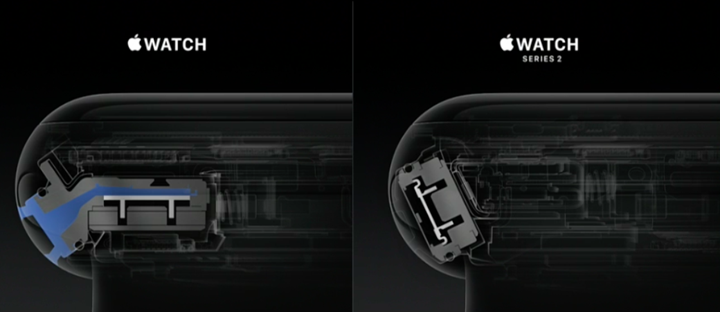
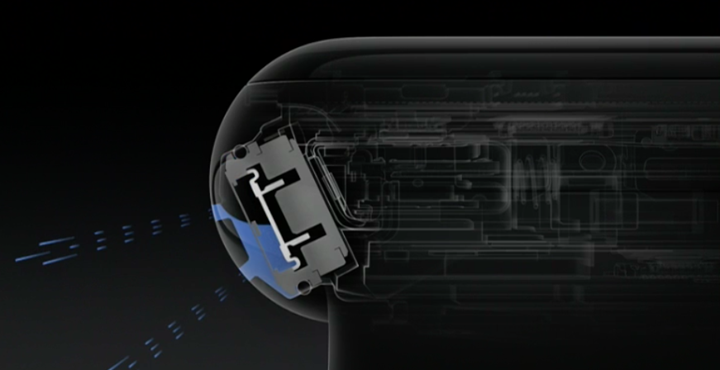
In case you’re curious how the Apple Watch Series 4 handles in the water compared to other competitors, here’s a complete video I put together on the topic:
Once you’ve completed your workout (no matter the type), you’ll get a summary page that you can look at. And you can dive more deeply into certain areas like heart rate stats as well from the watch.
Additionally, if you switch back to the phone app you can get more stats, including splits and a map of your route:
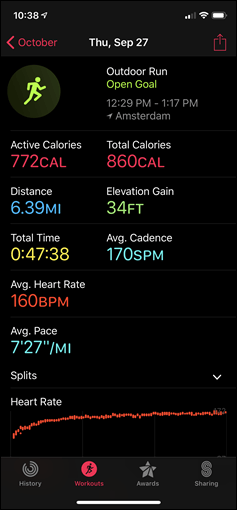
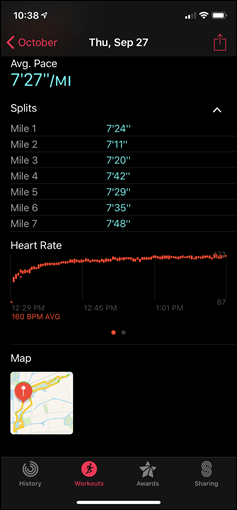
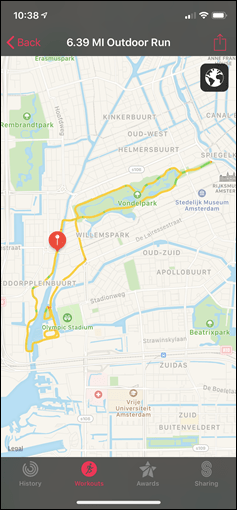
As I’ve noted in the past – most of this information is fairly basic in comparison to what other companies provide in the space, especially sport-specific companies like Garmin, Suunto, and Polar. You won’t find things like advanced recovery metrics, or training load. None of that makes it into the default Apple Watch experience. Some 3rd party apps have more details, but again, not Apple themselves.
Of course – no part of any Apple product is designed to appeal to the niche. It’s all about the mainstream. And metrics found in most sports watches (even ones that sell millions of units like the Garmin Fenix series) are simply deemed too specific for something that sells tens of millions of units. Or at least, that’s what Apple tells itself. And I’m not entirely sure they’re wrong.
Additionally, you won’t find features like fancy interval training in the Apple Watch either. And that’s actually an area that I think Apple is missing out on. After all, some of the most popular apps for the Apple Watch are focused on structured training. Still, Apple would likely contend that’s why they have such a vibrant app store with so many options. And again, I’m also not sure they’re wrong here either.
Finally, it’s worth noting somewhere that within WatchOS 5 the company has added automatic workout recognition. For running, walking (indoor/outdoor), swimming (open/pool), rowing machine, and elliptical usage it’ll automatically start an activity after three minutes of usage. This basically matches what Fitbit, Garmin, and others have been doing for years. Additionally, on the other end of things, when you complete a sport if you forget to stop it it’ll pop-up a little reminder that suggests you stop it (but you can also dismiss that too).
GPS Accuracy:
There’s likely no topic that stirs as much discussion and passion as GPS accuracy. A watch could fall apart and give you dire electrical shocks while doing so, but if it shows you on the wrong side of the road? Oh hell no, bring on the fury of the internet!
GPS accuracy can be looked at in a number of different ways, but I prefer to look at it using a number of devices in real-world scenarios across a vast number of activities. I use 2-6 other devices at once, trying to get a clear picture of how a given set of devices handles conditions on a certain day. Conditions include everything from tree/building cover to weather.
Over the years, I’ve continued to tweak my GPS testing methodology. For example, I try to not place two units next to each other on my wrists, as that can impact signal. If I do so, I’ll put a thin fabric spacer of about 1”/3cm between them (I didn’t do that on any of my Apple Watch Series 4 activities however, all workouts only had a single device per wrist). But often I’ll simply carry other units by the straps, or attach them to the shoulder straps of my hydration backpack. Plus, wearing multiple watches on the same wrist is well known to impact optical HR accuracy.
Next, as noted, I use just my daily training routes. Using a single route over and over again isn’t really indicative of real-world conditions, it’s just indicative of one trail. The workouts you see here are just my normal daily workouts.
I’ve had quite a bit of variety of terrain within the time period of Apple Watch testing. This has included runs in: Amsterdam, Banff mountains (Canada), and Cancun (Mexico). Cities and mountains, trees and open-air, plus oceans. It’s hit them all.
First up we’ll start with something relatively easy, a run around Amsterdam. I say easy because for the most part there aren’t any tall buildings along this specific path. In fact, much of it is in parks with only light tree cover. Here it is at a high level compared against a Garmin Forerunner 935 and a Suunto Trainer Wrist HR. The full sets/data files are here if you want to dive more deeply.
At a high level things mostly look OK, but I’m going to zoom into a few spots that are noteworthy. Oh, and for all my runs I did NOT take a phone with me. So this is using the native GPS on the watch itself.
You can see in the park that the Apple Watch really nails the GPS track on that upper straight segment. That may sound like an easy test (and to some degree it is), but that it gets close to perfectly correct is worthwhile pointing out. The Suunto is off in the bushes, and the Garmin has a slight wobble to it.
Scrolling around much of the rest of the track, you’ll note the Apple Watch easily handles this (as it should).
After a bit of time in the park I head out on the roads to get a bit of light buildings next to me. Nothing more than 3-5 stories tall. Note as I approach the traffic circle/park, how the Apple Watch (in purple) starts to head into the buildings though, and then crosses the middle of the green space (I stayed on the road where the other tracks show me):
Here, I’ll make this more clear:
It looks so…smooth? Curvy perhaps?
Yup, and that’s the infamous Apple Watch GPS track sashay. In the vast majority of quick directional changes it’ll overly smooth and even go off into the middle of nowhere. It’s as if it’s cornering itself around a race track and goes a bit wide initially to hit the inside corner at the turn.
But not always. For example, a few minutes later I do a loop around a small island, and it seems to get this correct:
My suspicion here is that the swooshing corners is directly related to either your speed or running cadence. In the case of this little island I had to slow down at each corner because the path was thin (and wet) and the corners all 90° or greater. Whereas in other cases I didn’t have to slow down, and that’s where it starts doing wild things.
For example, a mere two minutes later I do a loop around the track, which it perfectly nails – even getting my lane correct. See, I was on the inside lane most of the loop around, except on the southern (bottom) side of the track where I went wide to give room to a few guys doing 100m sprints on the inside lane there.
But what happens when I exit the track? It craps itself.
Here, in non-satellite view. It swoops itself out of the track, which is very much not what I did. I ran on the track itself and then doubled-back up the starting area of the track, up the path, and then down the path. In the case of Apple, it just swung itself around like a ballroom dancer.
Earlier in the review I showed a few other snippets of this same action as well. Mind you, this isn’t new to the Apple Watch Series 4. In fact, the Series 3 exhibited the exact same behavior. Depending on the circumstances, this can impact actual distance recorded as well. Sometimes longer, sometimes shorter – just depends on how it swooshes.
In any event, let’s look at another run, this time without the swooshes since there frankly weren’t enough tight turns for Apple to get into its swooshing groove. This one down in Cancun, Mexico and compared against the Garmin Instinct watch and the Suunto Trainer. Here’s the data:
Pretty much anywhere I go on this map, things look pretty good for the Apple Watch, which again bests Garmin and Suunto across many sections here:
The one exception? A squiggly road, where you can see clearly the Apple Watch do it’s swaying thing while the others more closely followed it (or attempted to). Once again showing it appears to be related to speed.
Next, we’ll head up to the frigid north of Canada into the mountains and forests for a run under tall snow and ice covered trees with mountains/cliffs on all sides. Here’s the data sets.
The portion of the route above where the Suunto cuts across is a mistake that occurred when I slipped and fell on the ice and managed to stop the watch in the process for a minute or two.
As I head around the lollipop of a route, the Apple Watch easily sticks to the road like white on rice:
Both the Garmin and Suunto units fail to track as closely as the Apple Watch does.
The only point on the entire route where the Apple Watch was briefly off-course was in the lower image, to the middle-left, where it goes a bit south of the road for perhaps 100m in duration (but only about 10 meters offset). The other watches in this section are equally or more sucky. Note the little squiggle that you see to the right side of the map was real, we went off the road to look at the elk.
Next, let’s head over to openwater swimming. In this case I had a Polar Vantage V on one wrist, and the Apple Watch on another. The yellow line is the reference track using a GPS atop a swim buoy behind me (see this video for details, also embedded up earlier in the sports section). Here’s the data.
If we remove the turquois colored track on turquois water, here’s what’s left:
This swim track can easily be summed up in one sentence: The most accurate swim track of the week, compared to 14 different swim tracks. I compared it against the Garmin Fenix 5 Plus, Suunto 9, Polar Vantage V, Suunto Trainer, and COROS Pace – and it easily beat all of them. Only the reference track was slightly better (because it was above water, hence the reference part).
I had shown this a bit in the past with other Apple Watch reviews, but I don’t think people really understand it – Apple’s killin’ it here with accuracy in openwater swimming. Perhaps all of that swooshing smoothing pays off, but the track is very very close to reality.
It’s time for Garmin, Suunto, and Polar to up their game. Which, if they read anything from this post, they should understand that. Swooshing aside (which is basically just over-eager software smoothing for aesthetic purposes), the Apple Watch is beating these companies at their own game when it comes to GPS accuracy.
Anyway, one more track, this time a cycling track. In this case I had my phone with me – which means it leverages the phone’s GPS (even if you don’t want it to).
And honestly, it’s pretty boring. There’s nothing ‘exciting’ (read: bad) anywhere on it. It’s perfectly on the roads at all times.
Well, actually, there was this one time where it swooshed its way around this corner, cutting it:
Phew, I was worried for a second that it had lost its swooshing mojo. Good to see it’s back.
So where are we on GPS accuracy?
Well, like life – it’s complicated.
On one hand, in most scenarios (hard or easy), the Apple Watch seems to outperform the best GPS devices out there today. It doesn’t seem to matter on the sport, it’s more stable in a large number of scenarios.
Yet on the other hand, this whole swooshing thing does legitimately take away from that. Whether or not you want your GPS to appear sexy, it’s fundamentally incorrect. I don’t typically run through buildings (only on Saturdays), nor off over rivers and lakes. And that reality can’t be overlooked.
I’m not sure which evil is worst – swooshing corners at high speeds (Apple) or a bit of track wobble here and there (everyone else). If Apple simply didn’t cut the corners all the time it’d easily win. But given that it does (and it’s seen on many people’s Apple Watch tracks), then it’s likely going to come down to some element of personal preference.
(Note: All of the charts in these accuracy sections were created using the DCR Analyzer tool. It allows you to compare power meters/trainers, heart rate, cadence, speed/pace, GPS tracks and plenty more. You can use it as well for your own gadget comparisons, more details here.)
Heart Rate Accuracy:
Next up we’ve got heart rate accuracy. This roughly falls into two buckets: 24×7 HR, and workout HR. As is usually the case with most devices these days, I see no tangible issues with 24×7 HR. It works well across both normal daily routines as well as things like sleep. Speaking of which, I talk about RHR values and 24×7 monitoring here and why it’s interesting.
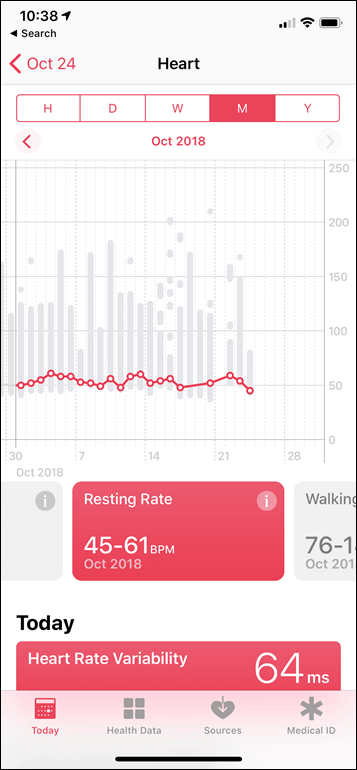
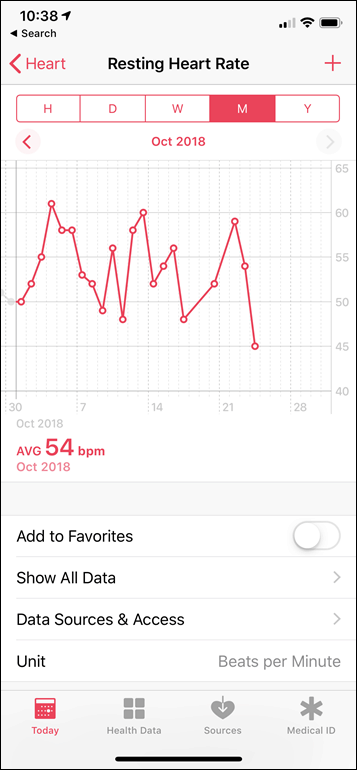
Before we move on to the test results, note that optical HR sensor accuracy is rather varied from individual to individual. Aspects such as skin color, hair density, and position can impact accuracy. Position, and how the band is worn, are *the most important* pieces. A unit with an optical HR sensor should be snug. It doesn’t need to leave marks, but you shouldn’t be able to slide a finger under the band (at least during workouts). You can wear it a tiny bit looser the rest of the day.
Ok, so in my testing, I simply use the watch throughout my normal workouts. Those workouts include a wide variety of intensities and conditions, making them great for accuracy testing. I’ve got steady runs, interval workouts on both bike and running, as well as openwater swimming – though, I didn’t focus on optical HR accuracy there.
For each test, I’m wearing additional devices, usually 3-4 in total, which capture data from other sensors. Typically I’d wear a chest strap (usually the HRM-TRI or Wahoo TICKR X, but also the Polar H7), as well as another optical HR sensor watch on the other wrist (and usually also a Scosche Rhythm 24). Note that the numbers you see in the upper right corner are *not* the averages, but rather just the exact point my mouse is sitting over. Note all this data is analyzed using the DCR Analyzer, details here.
First up from a heart rate standpoint is a relatively simple run in Mexico. I say simple in that there wasn’t any intervals or other complexities from a pace standpoint. Just straightforward slight ups and downs. It’s compared against a Garmin Instinct GPS watch on the other wrist, and then a TICKR-X heart rate strap via a Suunto Trainer Wrist HR. Here’s the data set:
The Suunto watch ran out of juice about a 1/3rd the way into the run, so we lost that comparison – but that’s OK, it’s pretty easy to see what happened.
But I want to start with the first 30 seconds though. Since that’s actually the most interesting bit of this entire run. Those three dots are at the most important point.
Remember earlier in the review how I mentioned Apple doesn’t perform a HR lock until after you press start? Well, that purple line is showing exactly that. It picks this random number (128bpm in this case) and records that until it has a good heart rate. In my case, my actual heart rate is shown in red by the Garmin Instinct – a nice steady/slow climb.
But it’s not until 24 seconds into the run that the Apple Watch locks the HR and starts climbing. Who knows what the Wahoo TICKR-X strap was doing the first 3 minutes of the run, so we’ll ignore that.
The rest of the run things are perfectly fine and the different HR sensors match just fine within a second or two of each other:
So let’s kick things up a notch and go for an interval run. This one has intervals of 400m each, and then 90 seconds of recovery. Pretty straightforward set, here’s the data from it.
At a high level, things look pretty good for the Apple Watch actually (in blue this time, barely visible directly matched to the other tracks). But let’s take a closer look at the first 30 seconds again:
Once again you can see it spits out a ‘fake’ initial starting value of 112bpm while it decides what its starting value will be. Exactly 20 seconds later it determines its real value as 111bpm and then starts tracking (it still isn’t correct for another 5-10 seconds).
You can see it meets the chest strap a few seconds later. In case you’re wondering why am I not critizing the green line (chest strap) in this case for having a gap? That’s simply because it wasn’t started for the first 8 or so seconds. Thus it doesn’t write a value to the file and I can’t display a value. Just wanted to clear that up.
In any case, moving along to the important part – the intervals:
Just going to highlight some key takeaways here:
A) The chest strap was definitely struggling at the peaks of each interval, but that’s fine for the purposes of showing you what’s going on here. What’s key is how perfect the Apple Watch is when it comes to nailing each one.
B) The Garmin Instinct fumbled a few times during the recovery phase of each interval (so the non-hard part), it was slightly delayed. You can see my HR lowering slower than the others.
C) There’s virtually not a single item to nitpick on this interval from the Apple Watch’s optical HR sensor.
Sérieusement. It’s about as perfect as you can get.
Next, let’s leave warm weather behind and head back to the cold. Colder weather is tougher for optical HR sensors as it’s harder to get readings until you warm up. Here’s the HR data from that snowy/icy Canadian run I talked about earlier.
Again, looking at the first few minutes we see the usual pattern of the Apple Watch waiting until it acquires a HR:
Now, in this scenario the TICKR-X was smokin’ something and started off at 170bpm – clearly incorrect for an easy run. The Garmin Instinct got the HR correct though from the beginning and shows a nice even ramp up. But it’s not until 63 seconds into the run that the Apple Watch manages to acquire my heart rate. Beurk.
At that point for the next 6 or so minutes there’s some clear disagreement on what my HR is. It’s fair to say it’s not the TICKR-X’s opinion of it. That’s wonky. The Apple Watch and Garmin Instinct aren’t actually that far apart for most of this, save about a 30 second period where they are about 15bpm apart. I don’t know which is most correct during that period.
For the remainder of the run though, things were pretty close between the units. The chest strap had a bit of wobble. I think it’s time to throw away that one, it’s got something up. But, the general gist of the three is correct.
Finally, we’ll wrap up with a look at an hour ride – about two hours long with a 15 or so minute stop for coffee in the middle. This is compared against the TICKR chest strap (apparently my non-problematic one). Here’s the data from that:
Like usual, it takes about half a minute for the Apple Watch to acquire HR after pressing start:
At which point, it honestly produces the best wrist-based optical HR sensor track I’ve ever seen during a bike ride. Seriously, it’s almost identical:
This level of accuracy during a ride easily puts Garmin to shame. In fact, if we add the Garmin Instinct’s optical HR sensor data to this track, we see exactly that (the yellow section is the coffee break):
And yup, for now I’d pretty easily give Apple the award for the most accurate wrist-based optical HR sensor out there today. Perhaps that’ll change with the Polar Vantage series in a few weeks, but for now – Apple’s holding that title…and doing so pretty easily.
If they’d just address the lack of initial acquisition piece – that’d be able to put a cherry atop it all. For many people that first 30 or so seconds probably isn’t as critical as the rest of the run. I know I’d personally prefer a watch that screws up the first 30 seconds but gets the next hour or so right…versus one that screws up the entire run but gets the first 30 seconds of warm-up right.
Data and Apps:
When it comes to apps, there’s a crapton of them that you can choose for your Apple Watch. Virtually all of them being 3rd party. But not all of them actually run on the watch itself. In fact, my ‘most favorite’ app for the Apple Watch doesn’t even run on the Apple Watch. Instead, it runs on my phone. But it’s the most important one I have.
See, despite the Apple Watch dumping all of your data into Apple Health, that doesn’t actually make it terribly useful to use with 3rd party platforms. For example, there’s inexplicably no native option to just connect your watch/phone to Strava and upload workouts from Apple Watch to Strava.
(Nitpickers corner: No, the Strava watch app actually doesn’t upload non-Strava workouts to Strava. Only workouts created within the Strava app are uploaded to Strava.)
All of the data goes into the massive repository that is Apple Health, which is accessible to apps (with your approval) via HealthKit. Note that this is kept entirely on your device. There is no cloud service or online platform for Apple Health data – a key differentiator (good and bad) from other companies’ platforms.
For most data, you can view it directly in Apple Health, via the ‘Health’ App on your phone. Some of this data, like steps and stand hours, have nifty graphs:
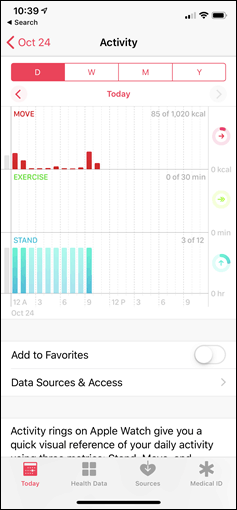
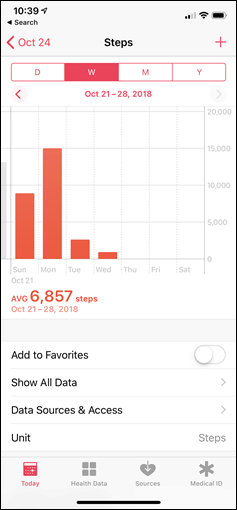
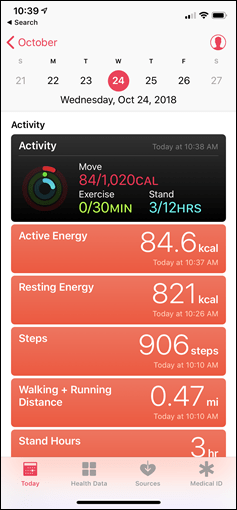
But lots of the data is a bit more nuanced in nature and dumped into huge database tables, though, you can still view those too:
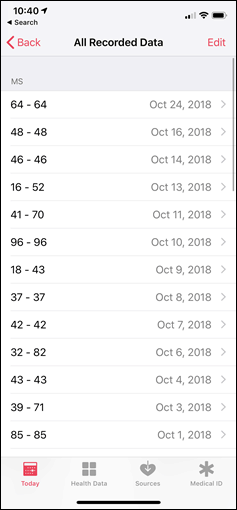
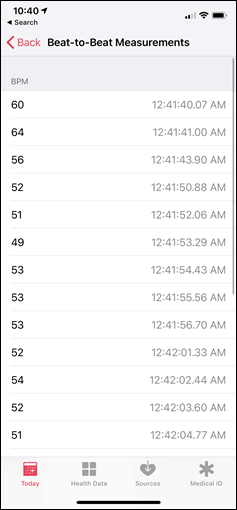
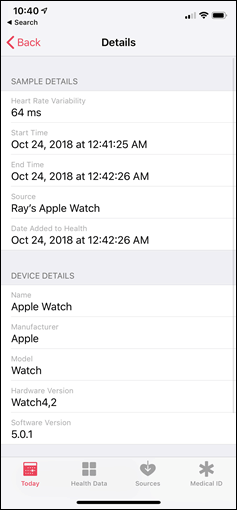
For me though, I ultimately want to take my Apple Watch workouts and push them to various platforms. For example, I want my runs to go to both Strava and Training Peaks. I use Strava for social sharing, whereas Training Peaks as my actual training log of record. If I just used the Strava Apple Watch app, then I couldn’t get the data to Training Peaks. So you can see why using the native app is more useful (or other 3rd party apps).
But in order to get that data to those platforms I have to use a 3rd party app – and without question my favorite is HealthFIT+. This app simply takes your workout data and compiles it into an industry standard file format, then uploads it to 3rd party platforms automatically for you. Specifically, these platforms. Additionally, you can control what platforms show up within the app too.
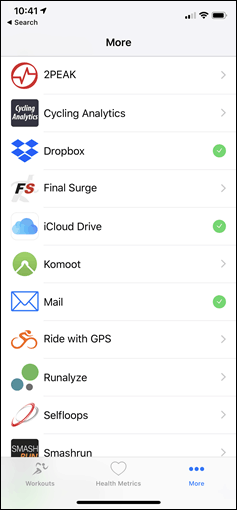
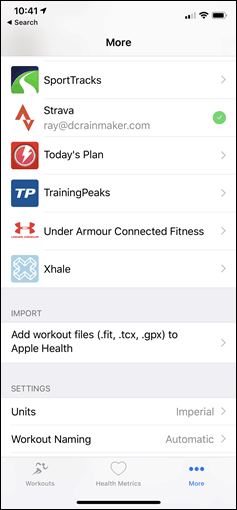
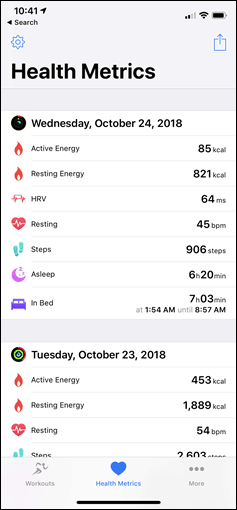
And here you can see some of my workouts within the app. I can tap on one or multiple workouts and manually share them to the services.
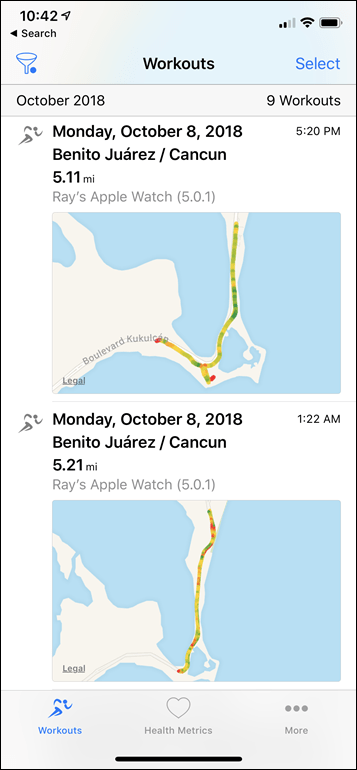
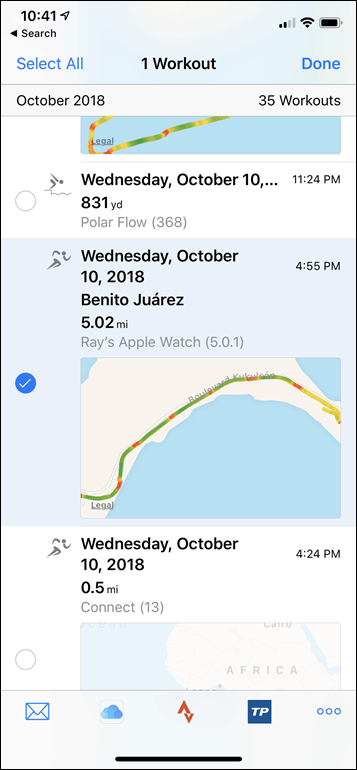
But what’s really cool here is I don’t even have to do anything if I want. It just does it automatically when I complete a workout using the default Apple Watch app. I’ll get a notification a few seconds later on my phone that it’s uploaded it to Strava, TrainingPeaks, and even Dropbox in my case. Below it shows ‘Sync 3 / 3’, which means it synced that workout correctly to all three platforms I setup (Strava, TrainingPeaks, Dropbox).
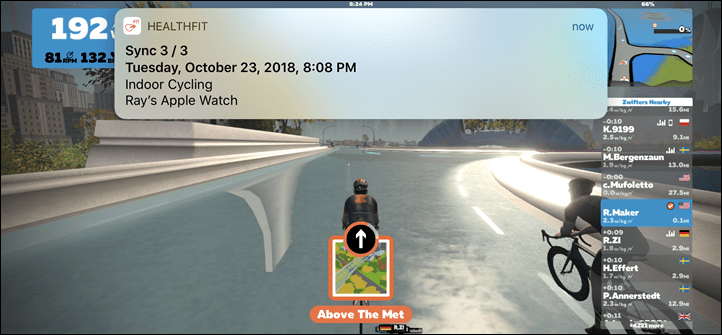
Totally awesome, and definitely worth the $2 fee. In fact, it’s via this app that I’m able to do all of the analysis you see in this post in terms of plotting the Apple Watch data against other watches.
(Note: I don’t have any paid/whatever affiliation with any of the above/below apps. I paid my two bucks or what-not for all of them…and plenty more.)
Here’s a quick look at a handful of apps that I’ve used that are useful from a sports/fitness standpoint:
WorkOutDoors: This is mapping/navigation focused and allows you to download a map segment to your Apple Watch for navigation. You can import in tracks/routes and then follow those tracks against the map on your watch. Basically, it’s like having a mini version of a Garmin Fenix 5 Plus (or 5X) series watch. Cool stuff.
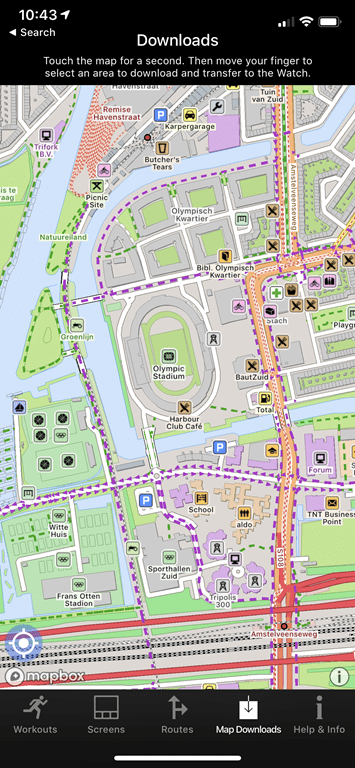
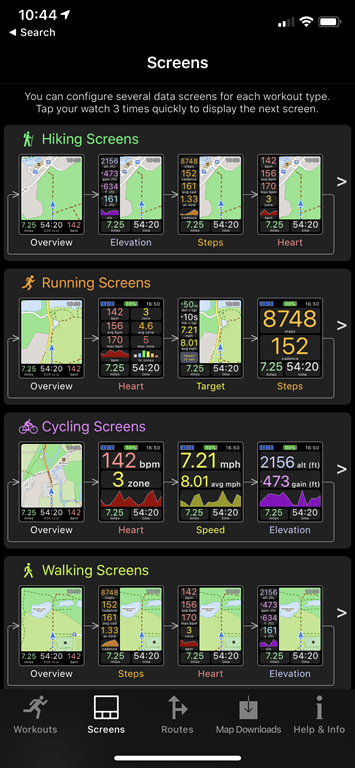
AutoSleep: I touched on this above a bit, but Apple itself doesn’t have any sleep tracking. So this app allows you to get sleep data on your Apple Watch. Unlike many apps – this requires zero end-user interaction. Some apps require you to ‘start’ and ‘stop’ your sleep, which I find silly and 1980’s like. This just does it all in the background magically and then you use the iPhone app to view the data. Sucré!
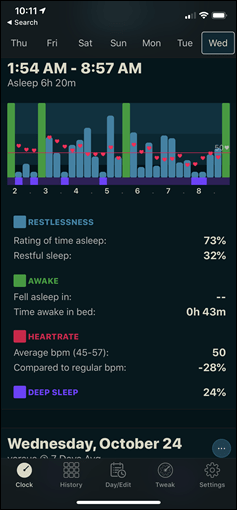
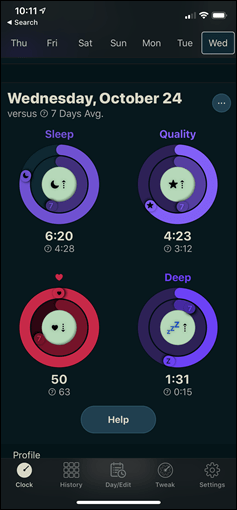
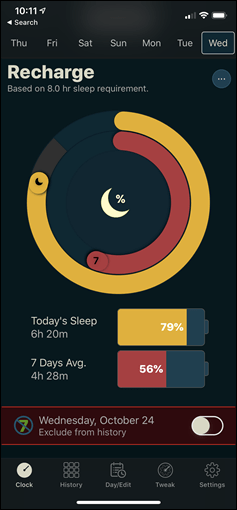
RunGap: This app is somewhat like HealthFit+ above. It allows you to upload/export to various services as well. I haven’t used this one as much merely since I’ve mostly just used HealthFit+. I’m kinda a ‘if it works don’t try and fix it’ kinda guy. Though I know plenty of people use RunGap, here’s a bit of a review from last year – but one from a source I trust that walks through the functions.
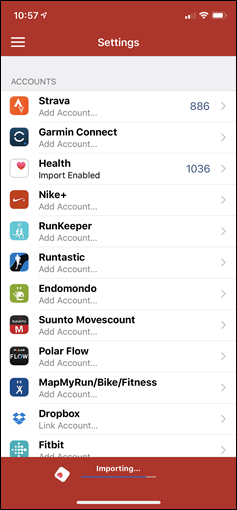
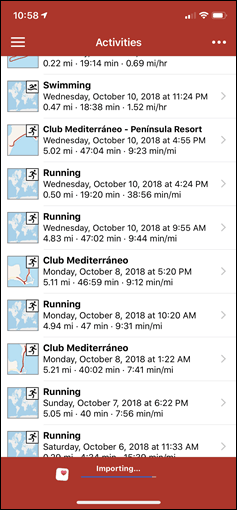
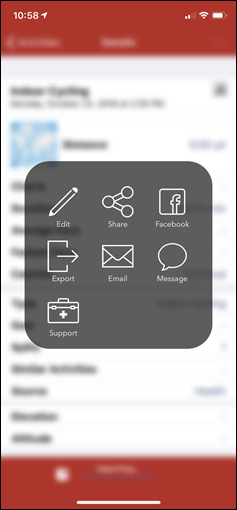
And finally, here’s a few more that DCR Readers have suggested as their top favorites after I posed the question to Twitter. I’ve used some of these off and on over the years.
iSmoothRun: There’s no app that has as many options for doing customized data pages, interval workouts and more. It’s basically what the Apple Watch running experience should be.
StrongApp: This is mainly designed for gym workouts, letting you track and program reps and rest intervals.
RunGo: This blends together a bit of iSmoothRun with WorkOutdoors – letting you record runs but still getting turn by turn navigation for those runs.
Plus many more repeated my recommendations for HealthFit+, RunGap, and WorkOutdoors.
One general caveat when looking at apps is to ensure the app is able to function in a standalone non-phone connected manner. Some apps have features that only work when in connection with a phone nearby (such as connecting to power meter sensors), while other apps can be fully freestyle and go tetherless.
Product Comparison:
I’ve added the Apple Watch Series 4 into the product comparison database, allowing you to compare it against other products that I’ve reviewed in the past.
For the purposes of below I’ve compared it against the Fitbit Ionic and the Garmin Vivoactive 3 Music, which are the ones most people will be comparing it against from a sports/fitness standpoint. Also note, with a unit like the Apple Watch specifically, there are many cases below where “with 3rd party apps” can be used. The same is largely true of Garmin, and somewhat with Fitbit. I’ve tried to thread the needle of apps that I roughly know exist where I’ve listed that. But it’s not a perfection in terms of knowing every app on earth. Ultimately, I don’t think any consumer does (or should).
| Function/Feature | Apple Watch série 4 | Fitbit Ionic | Garmin Vivoactive 3 Music |
|---|---|---|---|
| Copyright DC Rainmaker – Updated April 6th, 2019 @ 6:43 amNew Window | |||
| Prix | $399/$499 (cellular) | 269 $ | $279 |
| Product Announcement Date | Sept 12th, 2018 | Aug 28th, 2017 | June 13th, 2018 |
| Actual Availability/Shipping Date | Sept 21st, 2018 | Oct 1st, 2017 | June 13th, 2018 |
| GPS Recording Functionality | Oui | Oui | Oui |
| Data Transfer | Bluetooth Smart | Bluetooth Smart | USB, BLUETOOTH SMART |
| Étanchéité | 50m | 50m | 50 mètres |
| Battery Life (GPS) | 6hrs GPS on time (24-48hrs standby) | 10 heures | Up to 13 hours GPS |
| Recording Interval | Varies | 1-second | 1s or Smart Recording |
| Satellite Pre-Loading via Computer | Yes via phone | Oui | Oui |
| Quick Satellite Reception | Most times | Génial | Génial |
| Les alertes | Vibration/Audio/Visual | Visual/Vibrate | Vibrate/Visual |
| Backlight Greatness | Génial | Génial | Génial |
| Ability to download custom apps to unit/device | Oui | Oui | Oui |
| Acts as daily activity monitor (steps, etc…) | Oui | Oui | Oui | La musique | Apple Watch série 4 | Fitbit Ionic | Garmin Vivoactive 3 Music |
| Can control phone music | Oui | Oui | Oui |
| Has music storage and playback | Oui | Oui | Oui |
| Streaming Services | Apple Music | Pandora, Deezer | Deezer, iHeartRadio, Spotify (Soon) | Paiements | Apple Watch série 4 | Fitbit Ionic | Garmin Vivoactive 3 Music |
| Contactless-NFC Payments | Oui | Oui | Oui | Connectivité | Apple Watch série 4 | Fitbit Ionic | Garmin Vivoactive 3 Music |
| Bluetooth Legacy (pre-4.0) to Phone | Non | Non | Non |
| Bluetooth Smart (4.0+) to Phone Uploading | Oui | Oui | Oui |
| Phone Notifications to unit (i.e. texts/calls/etc…) | Oui | Oui | Oui |
| Live Tracking (streaming location to website) | With 3rd party apps | Non | Oui |
| Group tracking | Non | Non | Non |
| Emergency/SOS Message Notification (from watch to contacts) | Oui | Non | Non |
| Built-in cellular chip (no phone required) | Yes (with cellular version) | Non | Non | Cycling | Apple Watch série 4 | Fitbit Ionic | Garmin Vivoactive 3 Music |
| Designed for cycling | Oui | Oui | Oui |
| Power Meter Capable | Non | Non | With some Connect IQ apps |
| Speed/Cadence Sensor Capable | Non | Non | Oui |
| Strava segments live on device | Non | Non | Non |
| Crash detection | Non | Non | Non | Running | Apple Watch série 4 | Fitbit Ionic | Garmin Vivoactive 3 Music |
| Designed for running | Oui | Oui | Oui |
| Footpod Capable (For treadmills) | With 3rd party apps | No (but has treadmill functionality) | Oui |
| Running Dynamics (vertical oscillation, ground contact time, etc…) | Non | Non | Non |
| Running Power | With 3rd party apps | Non | Non |
| VO2Max Estimation | Oui | Yes via app | Oui |
| Race Predictor | Non | Non | Non |
| Recovery Advisor | Non | Non | Non |
| Run/Walk Mode | With 3rd party apps | Non | Oui | Swimming | Apple Watch série 4 | Fitbit Ionic | Garmin Vivoactive 3 Music |
| Designed for swimming | Oui | Oui | Oui |
| Openwater swimming mode | YEs | Non | Non |
| Lap/Indoor Distance Tracking | Oui | Oui | Oui |
| Record HR underwater | Oui | Non | Non |
| Openwater Metrics (Stroke/etc.) | Basic stroke type only | Non | Non |
| Indoor Metrics (Stroke/etc.) | Basic stroke type only | Oui | Oui |
| Indoor Drill Mode | Non | Non | Non |
| Indoor auto-pause feature | Oui | Non | Non |
| Change pool size | Oui | Oui | Oui |
| Indoor Min/Max Pool Lengths | 1y/m to 1,500y/m+ | 10m/y-100m/y | 17M/18Y TO 150Y/M |
| Ability to customize data fields | Très limité | Oui | Oui |
| Can change yards to meters | Oui | Oui | Oui |
| Captures per length data – indoors | Oui | Oui | |
| Indoor Alerts | Yes (goals) | Yes (distance) | Oui | Triathlon | Apple Watch série 4 | Fitbit Ionic | Garmin Vivoactive 3 Music |
| Designed for triathlon | Not really | Non | Non |
| Multisport mode | Oui | Non | Non | Workouts | Apple Watch série 4 | Fitbit Ionic | Garmin Vivoactive 3 Music |
| Create/Follow custom workouts | With 3rd party apps | No (Premium Coached only) | Oui |
| On-unit interval Feature | With 3rd party apps | Non | Sorta (2 preloaded ones, but no customization) |
| Training Calendar Functionality | With 3rd party apps | Non | Oui | Les fonctions | Apple Watch série 4 | Fitbit Ionic | Garmin Vivoactive 3 Music |
| Auto Start/Stop | Oui | Oui | Oui |
| Virtual Partner Feature | Sorta (Pacing feature) | Non | Non |
| Virtual Racer Feature | Non | Non | Non |
| Records PR's – Personal Records (diff than history) | Non | Non | Oui |
| Day to day watch ability | Oui | Oui | Oui |
| Hunting/Fishing/Ocean Data | Non | Non | Non |
| Tidal Tables (Tide Information) | Non | Non | Non |
| Jumpmaster mode (Parachuting) | Non | Non | Non |
| Géocaching | Non | Non | Non |
| Weather Display (live data) | Oui | Oui | Oui | Naviguer | Apple Watch série 4 | Fitbit Ionic | Garmin Vivoactive 3 Music |
| Follow GPS Track (Courses/Waypoints) | With 3rd party apps | Non | No (but some 3rd party apps can) |
| Markers/Waypoint Direction | With 3rd party apps | Non | Yes (to pre-saved spots) |
| Routable/Visual Maps (like car GPS) | With 3rd party apps | Non | Non |
| Back to start | With 3rd party apps | Non | YEs |
| Impromptu Round Trip Route Creation | With 3rd party apps | Non | Non |
| Download courses/routes from phone to unit | With 3rd party apps | Non | NON | Capteurs | Apple Watch série 4 | Fitbit Ionic | Garmin Vivoactive 3 Music |
| Altimeter Type | Barometric | Barometric | Barometric |
| Compass Type | N / A | N / A | Magnetic |
| Optical Heart Rate Sensor internally | Oui | Oui | Oui |
| Pulse Oximetry (aka Pulse Ox) | Non | Non | |
| Heart Rate Strap Compatible | Oui | Non | Oui |
| ANT+ Heart Rate Strap Capable | Non | Non | YEs |
| ANT+ Speed/Cadence Capable | non | Non | Oui |
| ANT+ Footpod Capable | Non | Non | Oui |
| ANT+ Power Meter Capable | Non | Non | Non |
| ANT+ Weight Scale Capable | Non | Non | Non |
| ANT+ Fitness Equipment (Gym) | Non | Non | Non |
| ANT+ Lighting Control | Non | Non | Oui |
| ANT+ Bike Radar Integration | Non | Non | Non |
| ANT+ Trainer Control (FE-C) | Non | Non | Non |
| ANT+ Remote Control | Non | Non | No (Yes for VIRB camera control) |
| ANT+ eBike Compatibility | Non | Non | Non |
| ANT+ Muscle Oxygen (i.e. Moxy/BSX) | Non | Non | non |
| ANT+ Gear Shifting (i.e. SRAM ETAP) | Non | Non | Non |
| Shimano Di2 Shifting | Non | Non | Non |
| Bluetooth Smart HR Strap Capable | Oui | Non | YEs |
| Bluetooth Smart Speed/Cadence Capable | Non | Non | Oui |
| Bluetooth Smart Footpod Capable | Non | Non | Oui |
| Bluetooth Smart Power Meter Capable | Non | Non | Non |
| Temp Recording (internal sensor) | Non | Non | Non |
| Temp Recording (external sensor) | Non | Non | Oui |
| Compatible with Firstbeat HR tools | Non | N / A | – | Logiciel | Apple Watch série 4 | Fitbit Ionic | Garmin Vivoactive 3 Music |
| PC Application | Aucun | PC/Mac | Garmin Express |
| Web Application | Aucun | Oui | Garmin Connect |
| Phone App | iOS only | iOS/Android/Windows | iOS/Android/Windows |
| Ability to Export Settings | Non | Non | Non | achat | Apple Watch série 4 | Fitbit Ionic | Garmin Vivoactive 3 Music |
| Amazon Link | Lien | Lien | Lien |
| Clever Training – Save with the VIP program | N / A | Lien | Lien |
| Clever Training Europe (Save 10% with DCR10BTF) | N / A | Lien | DCRainmaker | Apple Watch série 4 | Fitbit Ionic | Garmin Vivoactive 3 Music |
| Review Link | Lien | Lien | Lien |
Again, remember you can make your own comparison charts here using the product comparison tool/database.
For lack of anywhere else to stick battery life and my experience – I’m getting pretty consistently two full days of usage, with about 1-2hrs of GPS usage in there in total. So if I wake up around 8AM and take it off the charger then, I’m getting a low-battery power reserve warning around 9-10PM the following day. That’s been pretty consistent for me this last month.
Oh – and in case you’re wondering about the Nike+ Edition, there’s only a handful of differences there to the regular non-Nike+ variants:
– Nike+ Edition has unique Nike+ watch faces
– Nike+ Edition has unique/exclusive watch bands
And…that’s it. You can get the other Nike+ features using any Apple Watch, they aren’t limited to the Nike+ Editions. You can also install/utilize the Nike+ app on any Apple Watch as well (just not the special watch faces).
Résumé:
If one were to pull out a feature comparison of the Apple Watch Series 4 versus the Series 3, specific to sports and fitness, they’d likely just go ‘shrug’. Ultimately, the differences just aren’t there in the hardware side of things.
Instead, it’s really more about small changes in software of WatchOS 5 compared to WatchOS 4, and virtually all of those things are applicable to most past Apple Watch units anyways. The core hardware differences most visible on the Series 4 is the larger display and the different optical HR sensor. Plus, the yet to be implemented ECG feature.
But as I showed – under the covers there’s actually some substantial differences in term of accuracy. The optical HR sensor (or perhaps the algorithms Apple is using) is different. And as a result, accuracy has improved – at least once you get past that first minute. And the GPS sensor (or again, algorithms) is also improved, in many cases producing better results than Garmin, Suunto, or Polar’s latest wares.
Still, as capable as the Apple Watch has become – it’s still a tough pitch for endurance athletes. Be it the more limited battery life than others, the not-always-on screen, or just the lack of a multitude of buttons; it’s not likely to dominate the endurance market anytime soon. If one looks at Strava uploads for the Ironman World Championships a few weeks back as an example – not a single athlete (out of 2,500) uploaded a run or bike activity to Strava with an Apple Watch from the event (fun tidbit: a single person actually managed to use a Fitbit Ionic for the run/bike portions).
The Apple Watch has no doubt made gains when it comes to checking off aspects of the fitness market in the last few years, but I can’t help but think that if Apple actually spent time on their native fitness app to make it more competitive with even Fitbit (let alone more full-featured rivals like Garmin, Suunto, or Polar), they’d be able to more cohesively compete with those wearables – especially given their accuracy seems to stop them in some areas today.
Which isn’t to say Apple won’t sell millions more units. Rather, to point out that merely selling millions more of something doesn’t mean it’s the defacto answer for everyone. Choice is good, and it’s good to see Apple presenting a product that’s finally able to compete in more areas of sport and fitness.
With that – thanks for reading.
Found this review useful? Support the site! Continuer à lire!
Hopefully you found this review useful. At the end of the day, I’m an athlete just like you looking for the most detail possible on a new purchase – so my review is written from the standpoint of how I used the device. The reviews generally take a lot of hours to put together, so it’s a fair bit of work (and labor of love). As you probably noticed by looking below, I also take time to answer all the questions posted in the comments – and there’s quite a bit of detail in there as well.
If you’re a fan of Amazon, you can pick up Apple Watch Series 4 that way and it helps support the site! It doesn’t cost you anything extra, yet helps here a bunch. If you’re outside the US, it should automatically find the right Amazon country for you – but you can always use the big Amazon country links on the right sidebar if so! Oh, and in the future if you just click that Amazon logo before buying anything else (like laundry detergent or toilet paper), that supports the site too!
And of course – you can always sign-up to be a DCR Supporter! That gets you an ad-free DCR, and also makes you awesome. And being awesome is what it’s all about!
Merci d'avoir lu! And as always, feel free to post comments or questions in the comments section below, I’ll be happy to try and answer them as quickly as possible. And lastly, if you felt this review was useful – I always appreciate feedback in the comments below. Merci!
Commentaires
Laisser un commentaire